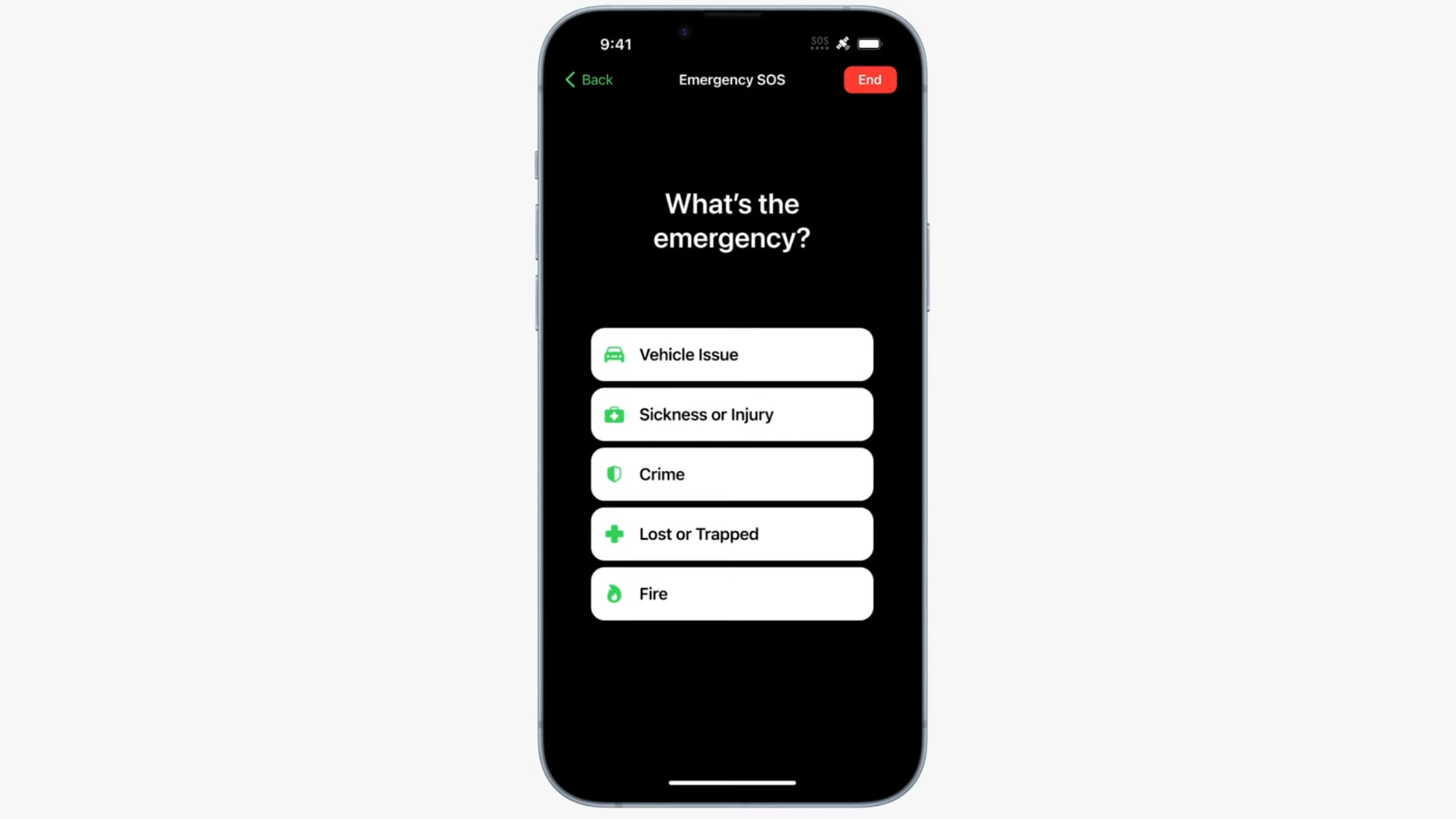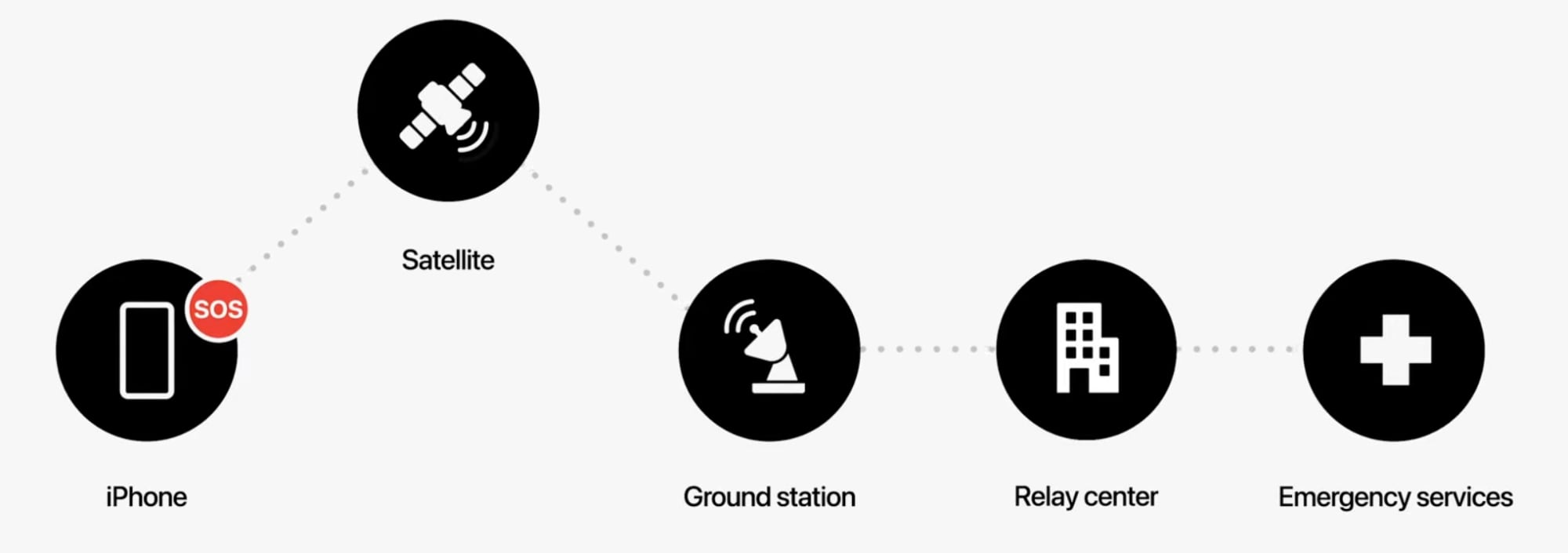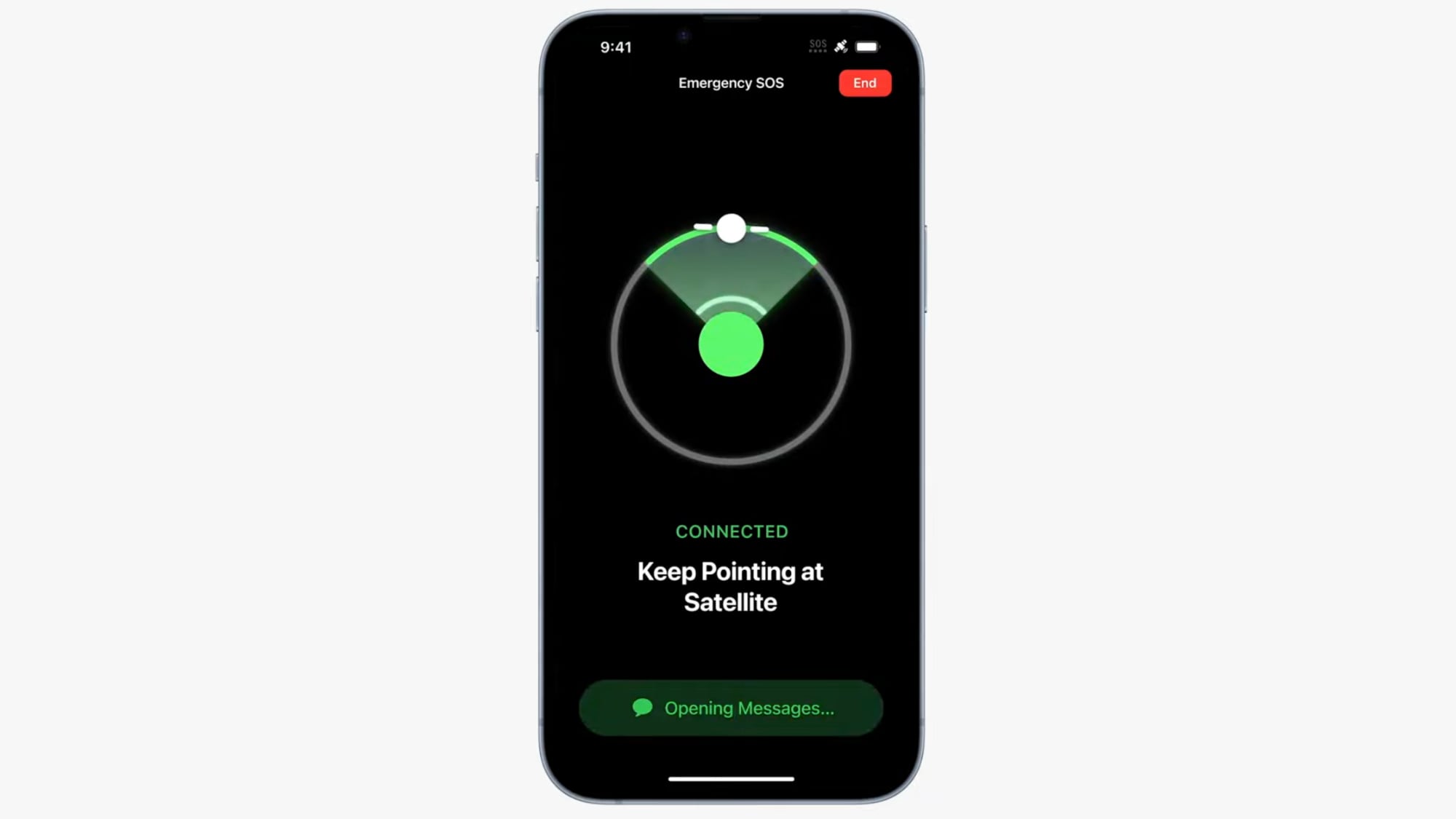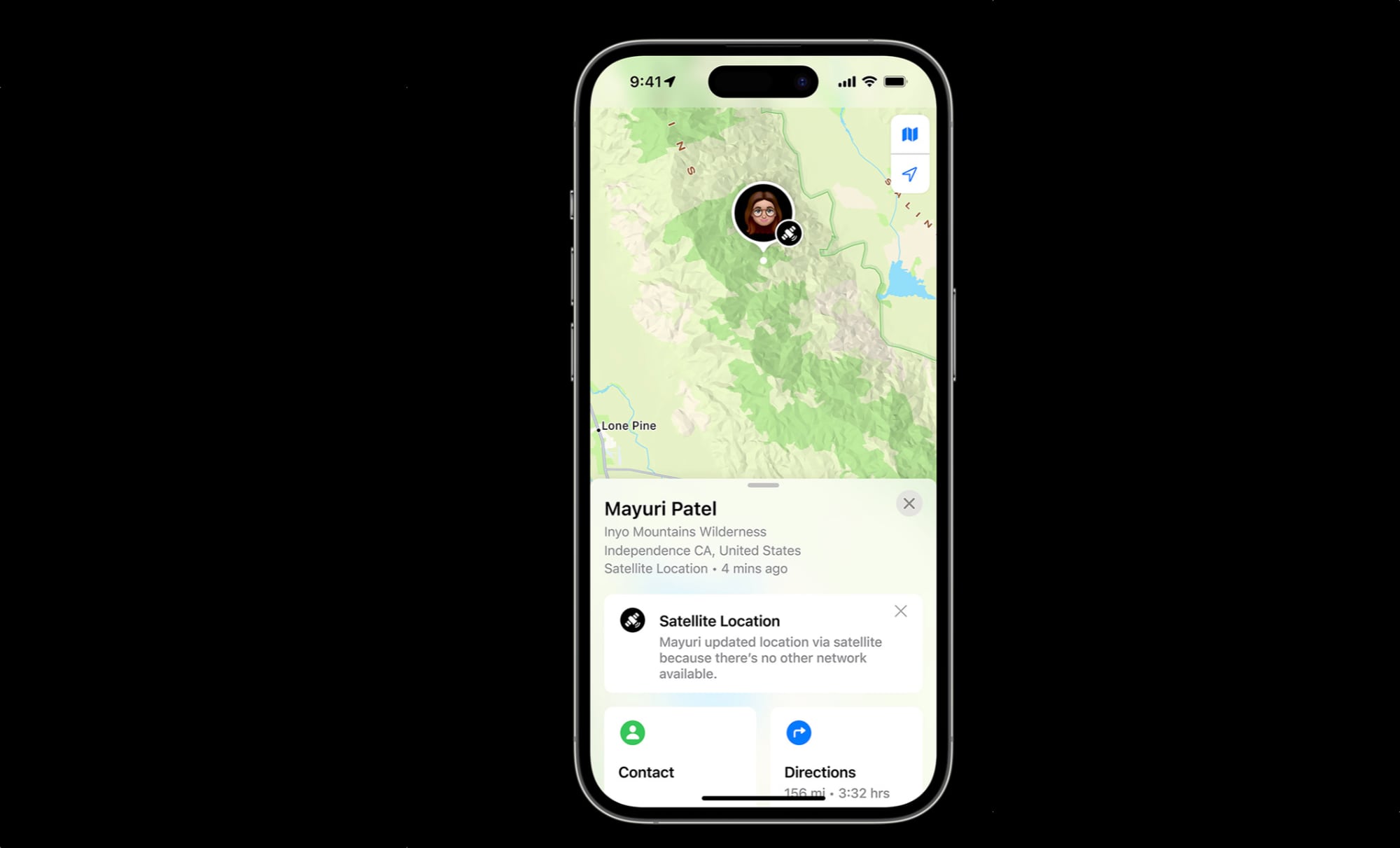Fall detection doesn’t work if you don’t have a WiFi or a cellular signal. It would tell you you’ve fallen, but you’d likely know that already. 😉Fall detection doesn't require maintaining a wildly expensive device that flies around in orbit.
Got a tip for us?
Let us know
Become a MacRumors Supporter for $50/year with no ads, ability to filter front page stories, and private forums.
What You Need to Know About Apple's Emergency Satellite Feature for iPhone 14
- Thread starter MacRumors
- Start date
- Sort by reaction score
You are using an out of date browser. It may not display this or other websites correctly.
You should upgrade or use an alternative browser.
You should upgrade or use an alternative browser.
Tough to compare when Apple has a service ready to deploy whilst the other one is just vaporware at this point, SpaceX doesn’t even have one single v2 satellite up in the sky and service wont be another year or two. From Musk’s track record, it probably will take at least 2-3 years to get that off the ground running. I do like the fact it is supposed to work with existing devices, unlike Apple making you buy new devices to get this feature. But the downside is that in the US it seems like it will only work on Tmobile. I have to say SpaceX-Tmo announcement seemed pre-maturely rushed out to the media, with very sketchy details, like others mentioned it was probably primarily a ploy to pre-empt Apple’s announcement.Starlink seems like 100x better solution without all these workaround that apple had to implement. T-mobile definitely scored a huge win with this exclusive. Apple needs to call up Elon to get that integrated for all.
That device is me when I fallFall detection doesn't require maintaining a wildly expensive device that flies around in orbit.
It seems the iPhone 14 series will have this working on release. When do you expect the T-Mobile / Starlink service to go live? I hear it’s in a limited beta right now, beyond that there’s no comment on it as a future venture…Starlink seems like 100x better solution without all these workaround that apple had to implement. T-mobile definitely scored a huge win with this exclusive. Apple needs to call up Elon to get that integrated for all.
One has nothing to do with the other. If fall detection is free now, then it will continue to be free. You see, the real issue is being able to let someone know you fell and need help. If you use wifi or cellular then perhaps you'll get help. But if you call in the middle of the Sahara desert, probably no wifi or cellular out there and no help. With the 14, you can use satellite in the desert to get help. If you don't want to pay for that service, then you'll still know you fell in the desert.I mostly have an issue with this not being a free feature. It's like being charged for fall detection after 2 years.
What g000 said. But also:How so? You can only text on both. No calling on either. What does inReach do better or more?
InReach (and devices like it, or satellite bridge devices like the Zoleo) are two-way satcom messengers and PLBs—personal locator beacons. By "two way messengers," I mean you can send and receive an arbitrary number of messages (either custom or templated) to an unlimited number of recipients using the Iridium satellite network which is world-wide.
Apple's solution is limited two-way messaging to emergency personnel only (that's why I referred to it as a "fancy" PLB) and uses the Globalstar network. Globalstar's big appeal has always been that they're cheaper, although their service is a lot more spotty, and likely why Apple limited it to North America.
Also, satcom devices have large antennas to improve signal lock speed, but the large antennas are not a requirement. The InReach Mini is 2.04” x 3.90” x 1.03”, most of which is the chonky battery which allows for 2+ weeks of use between charges. There's also the Zoleo I mentioned earlier, which is 3.58" x 2.6" x 1.06" Again, mostly battery. Clip it to your pack and forget about it.
There's absolutely nothing wrong with what Apple has done here. It's a great service for unplanned emergencies. But there's a point to carrying a separate device for different needs. When I'm in the backcountry, I certainly would appreciate if my phone could act as a PLB, but I'd still carry a satcom device for general messaging, durability, and battery life.
Last edited:
I would hope this feature doesn't overwhelm emergency services and can vet actual emergencies. Each Summer here in Colorado they are working non-stop especially weekends getting tourists out of trouble.
I secretly was hoping Apple would bring the ability to use Sirius XM or FM radio in some capacity for disasters so you can tune in and determine where to go for safety. I've been in a few situations where the cell towers were overwhelmed or taken offline due to a tropical storm.
I secretly was hoping Apple would bring the ability to use Sirius XM or FM radio in some capacity for disasters so you can tune in and determine where to go for safety. I've been in a few situations where the cell towers were overwhelmed or taken offline due to a tropical storm.
Fellow CO resident here. I sort of smirked at Apple's "HERE COMES THE RESCUE HELICOPTER!" dramatization. Of course there are actual rescue helicopters. But more often than not, it's volunteers who have to hike in to where you are, triage you, and *then* call in the helicopter if warranted. Otherwise, they're carrying you out. Breaking your ankle in the mountains can often mean a very long, painful, cold night alone waiting, and then a delicate hike down the next morning. The best solution to needing rescue is not to get yourself into a situation where you need rescue.I would hope this feature doesn't overwhelm emergency services and can vet actual emergencies. Each Summer here in Colorado they are working non-stop especially weekends getting tourists out of trouble.
What sites are saying this will be yet another subscription service and everyone knows subscription services are Apple main focus lately. But this being for emergencies only why not just charge per connection even if that is a steep fee so all new iPhone owners have that ability. If I was in an a emergency out in middle of nowhere I would gladly pay $$$ for a satellite connection for help.
With the iPhone 14 models, Apple is introducing a new Emergency SOS via satellite feature that is designed to allow emergency messages to be sent even when cellular and WiFi connections are unavailable.
We thought we'd highlight some of the features of the new satellite functionality for those of you who are curious about how it works.
When It Works
Satellite connectivity is available to be used whenever you are out of range of WiFi or cellular and need to send an emergency message.

Apple says that it was designed for use in open spaces with a clear line of sight to the sky, so performance may be impacted if there are trees or buildings that are nearby.
Messaging Options
You can't make phone calls using the SOS via Satellite feature, but you can send short text messages. The iPhone will actually front-load vital questions to assess your situation, and it will send that information to emergency personnel as soon as you're connected.

Apple created a compression algorithm that makes text messages three times smaller to speed up communication as much as possible.
If you're in an area where emergency services can receive text messages, the text message will be sent directly, otherwise it will go to a relay center with Apple-trained specialists that will be able to place an emergency call for you.

Accessing Satellite Connectivity
Using satellite functionality requires your iPhone to connect to a satellite in the sky, so the iPhone will walk you through where to point your iPhone to get it connected to the nearest satellite.

Time Delays
Apple says that if you have a clear view of the sky, a short message can be sent within 15 seconds, but it can also take several minutes if there are obstructions.
Find My Integration
Through satellite connectivity, iPhone users can share their location over Find My even when there is no cellular or WiFi connection, which provides additional security for those camping or hiking in remote areas.

Crash Detection
The iPhone 14 models have a new dual-core accelerometer that can detect G-force measurements up to 256Gs, and a new high dynamic range gyroscope, both of which are for Crash Detection. Crash Detection is a new feature that pairs with emergency satellite, as it allows you to get help even if you crash in a remote location.
Globalstar Partnership
According to an SEC filing submitted following Apple's event, Apple is working with Globalstar on the satellite connectivity feature. Globalstar will be Apple's satellite operator, and it has agreed to allocate 85 percent of its current and future network capacity to support Apple's iPhones.
Globalstar and Apple's contract says that Globalstar will provide and maintain all resources, including personnel, software, satellite systems, and more, and maintain minimum quality and coverage standards.
Pricing
Apple has not provided details on how much satellite connectivity will cost, but all iPhone 14 users will get two years of satellite connectivity for free.
Availability
Satellite connectivity will be available in the United States and Canada on all iPhone 14 models. International travelers who visit the United States and Canada can use Emergency SOS via satellite, except if they bought their phone in China mainland, Hong Kong, or Macao, as Emergency SOS via satellite isn't offered in those countries.
Apple says that Emergency SOS via satellite might not work in places above 62° latitude, such as northern parts of Canada and Alaska.
Launch Date
Emergency SOS via satellite is set to launch in November.
Article Link: What You Need to Know About Apple's Emergency Satellite Feature for iPhone 14
I love the entitlement...buh buh if you are in the Serengeti and your $300k G 63 AMG runs out of $8/gallon 95 octane gas, and needed help, Apple should ensure it's satellites are totally free just in case and if it isn't free and you didn't pay a monthly plan you die? Apple! It's Apple's fault!!1!1! Apple literally wanted me to die because they are a greedy corporation !!
Lolno
Lolno
Fortunately there's a roof in the wayYou can bet a lot of people are going to use this for when they are lost at the mall. "Heeeeeeeeelp, I can't find Lululemon and Cheesecake factory!" 🤣
What a lot of people haven't thought about is how much a rescue costs. A lot of people think these rescues are free but they cost upwards of $10K plus depending on what assets are needed, That's why a lot of these other services like SPOT offer insurance plans. Yes, this is great if you really are in an emergency but I can see some random person is just going to use it because they lost cell service and find out the real bill in the end.
Last edited:
It seems the iPhone 14 series will have this working on release. When do you expect the T-Mobile / Starlink service to go live? I hear it’s in a limited beta right now, beyond that there’s no comment on it as a future venture…
This isn’t true, your body can easily sustain that kind of force over a fraction of a second, which is what happens when you collide with something. A large force over a small time scale isn’t like a bug on a window, but more like a bone breaking. I imagine in a crash your watch could very likely collide with a hard surface, which would register as an incredibly high g force event, even though it didn’t feel that way on your armIf your iPhone (and you) are in an accident that produces acceleration of 256 G, they won't need to send emergency services - they'll send somebody with a mop and sponge.
Apple said you will be able to see other persons position in Find My. So that would be the similar as inReach.InReach service will track you automatically every 2 or 10 minutes depending on subscription plan, the tracking data is accessible via website. Followers can also ping your device to get your most current location. You can also send location requests, get weather conditions. Inreach also has better battery life. But the negative is you have to carry an additional device with you, and the other negative is cost of the device and subscription plan.
It's a chat, the bubbles will be gray for emergency service messages.No mention if there is any confirmation that your emergency message was received? And no way for emergency services to reply?
I dirt bike a lot, and sometimes very far from humanity and a lot of times end up in places at night. Currently we use Zoleo which kind of sucks, as it's never really "connected" (sometimes sends location, sometimes not, etc). Messages received most of the time don't show up, until an hour later.
Given in the USA a helicopter extraction is like 100k+$ , what would be awesome is if you can send SOS messages to a contact instead. A button for "hey bro, come find my dead body here".
What I'm wondering is, i'm seeing articles say you can send SOS messages to others, and a lot of folks saying it's only to emergency services. So can we send short messages to a contact or we have to pay 100k to use the feature?
Given in the USA a helicopter extraction is like 100k+$ , what would be awesome is if you can send SOS messages to a contact instead. A button for "hey bro, come find my dead body here".
What I'm wondering is, i'm seeing articles say you can send SOS messages to others, and a lot of folks saying it's only to emergency services. So can we send short messages to a contact or we have to pay 100k to use the feature?
Good point. I have an inReach and can send texts to and from my wife (or anyone) via satellite. One can also send pre-written texts for free, like: "Running late, all is OK" along with your mapped location. Texts that are not prewritten cost extra. My current preset (free) messages are the following, each of which automatically sends a link to my mapped location:What g000 said. But also:
InReach (and devices like it, or satellite bridge devices like the Zoleo) are two-way satcom messengers and PLBs—personal locator beacons. By "two way messengers," I mean you can send and receive an arbitrary number of messages (either custom or templated) to an unlimited number of recipients using the Iridium satellite network which is world-wide.
I am here, all is OK
Delayed, but everything is OK
Pick me up here, please
The inReach mini is pretty small, but best to use it conjunction with a smartphone to be practical (has no keyboard).
Last edited:
Based on everything else Apple has kept US only for the last 5 years: never.When will this be available in other countries?…
I pay $300/year for my spot gps. So basically Apple is giving me a free phone with this service for 2 years. No brainer for me! I fly small aircraft in remote Canadian locations so this will be pretty sweet knowing I have this ability to connect for search and rescue.
From Garmin (not Apple), btw:Based on everything else Apple has kept US only for the last 5 years: never.
Planning a trip to the middle of nowhere? Add it to your plan. Otherwise keep it off. A feature that could very well save your life definitely worth a few bucks$9.99/month eventually…?
Garmin have a tricky way of pricing this. If you sign up for continuous service the monthly rate is cheaper than if you sign up for occasional service (where you can start and stop service), which has a yearly fee even if you don't use it. Consequently I signed up for continuous service.Planning a trip to the middle of nowhere? Add it to your plan. Otherwise keep it off. A feature that could very well save your life definitely worth a few bucks
Last edited:
Register on MacRumors! This sidebar will go away, and you'll see fewer ads.


